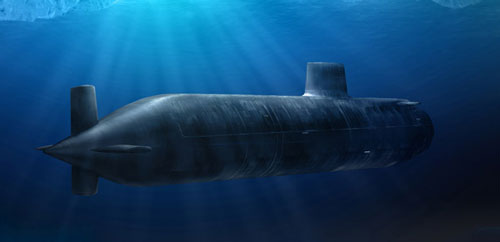return to homepage
return to updates
THE LIGHT-SPEED SUBMARINE PROBLEM
by Miles Mathis
In July of 2003, Physical Review D published a report on the “light-speed submarine problem.” This is a problem several decades old that many top physicists have spent much time on. A couple of them are said to have found solutions, including an SR solution in 1989 by James Supplee and a GR solution by George Matsas in 2002. A reader sent me a link to this report because Supplee solves by letting the ocean (but not the sub) accelerate upwards at g. The reader thought I would be interested in this, since it mirrors my SR solutions of GR problems.
Unfortunately, I found the whole problem absurd. Yes, Supplee does solve the problem in a way that mirrors my solutions, but the problem has a much simpler answer. The answer is that the problem is misdefined from the beginning.
We are given a submarine moving at a speed near c. Since observers will see the submarine as shorter and denser, they would expect it to sink. Why doesn't it?
It doesn't because what the observers see entails nothing about the local mechanics of bouyancy. Relativity is a math that supplies transforms for data. The data is skewed by the relative motion. It is this skewing that causes the need for the transforms. The local data does not match the observed data, so transforms are required. But of course this means that, logically, the observers are not observing the local relationship between the sub and the water. If they were, they wouldn't need transforms. It is the local relationship between the sub and the water that determines whether the sub sinks or floats, so what an observer sees is mechanically immaterial.
The local relationship between the sub and the water is not affected by Relativity, since Relativity requires a distance separation. Locally, the sub is neither shorter nor denser than it was at a slower speed, so the whole problem is a manufactured one.
We are given another problem, that being that the sailors inside the sub would see the water getting denser, which would make the sub move up. But even supposing that submarines had windows, this is again a manufactured problem. Both SR and GR require a time separation, so only water at some distance would be measured as denser. But the sub is not moving through that water. The sub is moving through local water. Since Relativity does not apply locally, what the sailors see or measure in this case is again mechanically immaterial.
These physicists are only wasting time “solving” a self-created contradiction, and they are doing this because they don't understand the first postulates of Relativity. They assume that what distant observers see is physically determinant, when it cannot be. What observers see is different from local numbers. If it weren't, there would be no need for Relativity. But two sets of numbers can't both be physically determinant. As a matter of bouyancy, the submarine can only have one length and one density. The local numbers are the ones that determine the physics. The observed numbers are only observed. That is, they are false.
Notice that I am not contradicting Relativity. I believe in Relativity and always have. But to have Relativity you have to have two co-ordinate systems and therefore two sets of numbers. Both sets of numbers are valid, in the sense that the data is significant for both. But both sets of numbers cannot determine the mechanics, since the submarine can only do one thing at a time. It cannot both sink and float. Clearly, the local numbers must determine the mechanics, and the local numbers simply consist of at-rest numbers. If you are given only the observed numbers and want the local numbers, you just have to work the transforms backwards. In a nutshell, that is what I assume Supplee and Matsas were doing. But if you want to answer the question as stated, you don't even need to go to that trouble. The answer is that the observations don't cause the sub to sink or rise, because observations don't cause motions. Local relationships cause motions.
If this paper was useful to you in any way, please consider donating a dollar (or more) to the SAVE THE ARTISTS FOUNDATION. This will allow me to continue writing these "unpublishable" things. Don't be confused by paying Melisa Smith--that is just one of my many noms de plume. If you are a Paypal user, there is no fee; so it might be worth your while to become one. Otherwise they will rob us 33 cents for each transaction.